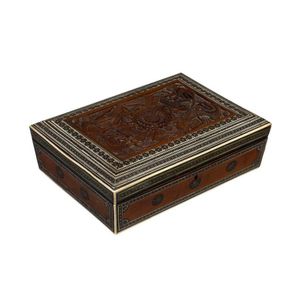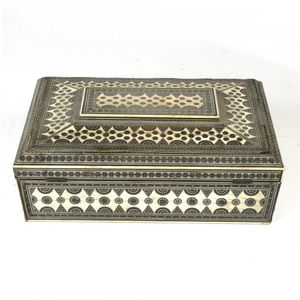Anglo-Indian Tortoiseshell Jewellery Box
You must be a subscriber, and be logged in to view price and dealer details.
Subscribe Now to view actual auction price for this item
When you subscribe, you have the option of setting the currency in which to display prices to $Au, $US, $NZ or Stg.
- Ivory - Ivory is a hard white material that comes from the tusks of elephants, mammoth, walrus and boar, or from the teeth of hippopotamus and whales. The ivory from the African elephant is the most prized source of ivory. Although the mammoth is extinct, tusks are still being unearthed in Russia and offered for sale.
Ivory has been used since the earliest times as a material for sculpture of small items, both in Europe and the east, principally China and Japan.
In Asia ivory has been carved for netsuke, seals, okimono, card cases, fan supports, animals and other figures and even as carved tusks.
In the last 200 years in Europe ivory has been used to carve figures, for elaborate tankards, snuff boxes, cane handles, embroidery and sewing accessories, in jewellery and as inlay on furniture. Its more practical uses include being used for billiard balls, buttons, and a veneers on the top of piano keys.
The use and trade of elephant ivory have become controversial because they have contributed to Due to the decline in elephant populations because of the trade in ivory, the Asian elephant was placed on Appendix One of the Convention on International Trade in Endangered Species (CITES), in 1975, and in January 1990, the African elephant was similarly listed. Under Appendix One, international trade in Asian or African elephant ivory between member countries is forbidden. Unlike trade in elephant tusks, trade in mammoth tusks is legal.
Since the invention of plastics, there have been many attempts to create an artificial ivory - Tortoiseshell - Tortoiseshell is a translucent material that comes from the horny carapace of a certain types of turtles, including the hawksbill turtle. It is often therefore mounted on a colour underground - often red - or inlaid with gold or silver thread, as seen in Boulle furniture.
The texture and colour nuances of the material are extremely important. Heated tortoiseshell can easily be formed into various shapes. Like other natural materials, tortoiseshell becomes more beautiful with use. In a time before plastic, tortoiseshell was widely used for small objects such as combs and powder compacts.
In 1973, the trade of tortoiseshell worldwide was banned under CITES (The Convention on International Trade in Endangered Species). Prior to importing or exporting items containing tortoiseshell a CITES permit must be obtained. Tortoiseshell items cannot be traded on Ebay.
"Faux tortoiseshell", another case of man initiating nature, is made from old-style plastics such as celluloid and cellulos and is coloured with red, yellow and brown spots to imitate the genuine article. It is commonly used in glasses frames, musical instruments and costume jewellery. - Sandalwood - Sandalwood is a heavy, yellow coloured and very fine-grained timber, which has a fragrance which lasts for many decades, and acts as a deterent to moths and insects.
In the British colonial era, sandalwood was imported into Britain from India, and the wood also used within India for the manufacture of Anglo-Indian furniture.
Becasue it does not have a distinct grain pattern, sandalwood was not used for the exterior surfaces of furniture, but was put to use for drawer and box linings, where the aroma was noticeable one the object was opened. it was also used to manufacture small objects (treen).
Nowadays sandalwood is commercially grown with Australia the largest producer. As well as producing timber, oil is extracted for use in the manufacture of perfumes.
This item has been included into following indexes:
Visually similar items

An Anglo-Indian carved and ivory inlaid sewing box, circa 1900, decorated with monkeys and birds, fitted interior, 9 cm high, 25 cm wide, 19 cm deep

An Indian Vizagapatam ivory work/sewing box, the interior with multiple compartments and various bobbins, etc. Some repairs. 23 cm x 32.5 cm x 11.5 cm.

A Napoleon III boulle casket, French, 19th century, 14 cm high, 32.5 cm wide, 25 cm deep

A French marquetry jewellery box, oblong with canted corners, the lid inlaid with a cut brass cartouche on a field of burr maple, framed by shell and brass borders inlaid in ebony and palisander. Conforming decoration to the fascia with similar to the side
